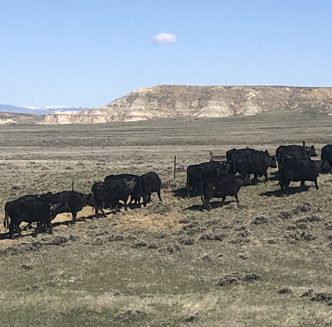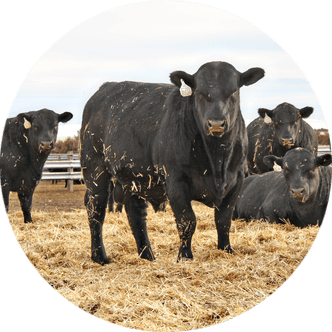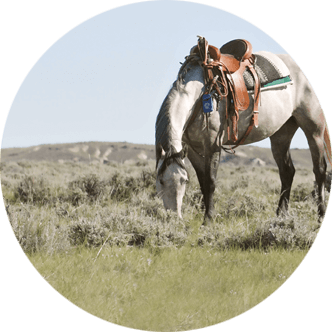MSU scientists analyzing how nutrients in beef are impacted by what cattle eat
Instead of answering, “Where’s the beef?” Michigan State University (MSU) scientists are gaining a deeper understanding of what’s in the beef.
A paper recently published by two MSU researchers highlights new data on how the nutrient composition and healthfulness of beef is impacted by what beef cattle feed on.
Fatty acids in grass-fed beef
Jenifer Fenton, a professor in the MSU Department of Food Science and Human Nutrition, and C.S. Mott Professor of Sustainable Agriculture in the Department of Animal Science Jason Rowntree published their findings in October 2024 in npj Science of Food.
Funded by the Greenacres Foundation, Fenton and Rowntree, whose work is also supported by MSU AgBioResearch, examined fatty acids and other organic compounds in grass-finished beef from cattle raised using rotational grazing methods, specifically studying whether analyzing the nutritional components in beef can lead to accurate predictions on what cattle were fed.
Being able to determine the feedstuff cattle ate – such as grass, supplemental feeds or grains – based on the nutrients found in beef could create an approach for how grass-finished beef can be authenticated.
Previous research of theirs published in 2022 in Frontiers in Sustainable Food Systems confirmed several nutritional benefits of grass-finished beef compared to grain-finished beef from cattle fed barley, oats or corn. These benefits included less fat, more omega-3 polyunsaturated fatty acids – which support heart health – and a lower omega-6 to omega-3 ratio.
Too high of a ratio can cause inflammation in the body and heighten disease risk.
“There’s variation in beef, yet we tend to put it under one umbrella,” Rowntree said. “I often say beef is healthy, but there’s nuance to it.”
Fenton said the omega-6 to omega-3 ratio in grass-finished beef is usually about two-to-one. However, some samples her team previously collected had ratios as high as 28.3-to-one.
“How you feed the animal can change the omega-6 to omega-3 profile dramatically,” Fenton said. “Salmon is one example that gets talked about a lot. Farm-raised salmon, when fed corn and soy, contain higher amounts of omega-6 fatty acids compared to wild salmon, which contain more omega-3 fatty acids because they’re feeding on small fish which eat algae.”
“The same concept is true for beef,” she continued. “When cattle are fed a high proportion of corn and soy, the beef has higher amounts of omega-6 relative to omega-3. On the commercial project we did prior, we saw wide variations in the ratio from two-to-one all the way to 20-to-one and more, but the beef samples should’ve all been close to two-to-one because they were purportedly grass-finished. So, we’ve been working to identify potential supplemental feeds which might explain the variation.”
Supplemental feeds
For some farmers and ranchers who practice rotational grazing and produce beef labeled to be grass-finished, fresh forage isn’t always available for cattle due to snow cover and other seasonal interruptions. As a result, cattle are fed supplemental feeds such as hay, baleage, soybean hulls and other diets.
The American Grassfed Association provides an approved list of supplemental feeds for cattle grown to produce grass-finished beef, but Fenton and Rowntree sought to provide evidence supporting ways to accurately authenticate grass-finished beef.
They did this by observing differences among the fatty acids and secondary metabolites in the beef they sampled, and then predicted which feeds were fed to cattle based on the information they recorded.
Secondary metabolites refer to bioactive compounds that aren’t associated with cell growth or development but play a role in how organisms function and survive in relation to their environment.
Previous studies – including one funded partly by Michigan Alliance of Animal Agriculture and published by Fenton and Rowntree in 2023 – have demonstrated how secondary metabolites produced by plants responding to their environment have antioxidants and anti-inflammatory agents which can be transferred to cattle fed on grass.
Rowntree said land management will continue to be an important research topic moving forward to ensure the feedstuff cattle eat and graze on is nutrient dense.
“There is a unique demand for understanding the nutrient density of the food we produce,” Rowntree said. “Our premise is healthy soils equal healthy land, and healthy land equals healthy plants, animals and people. Understanding how management influences the nutrients in food is a growing and much needed area.”
For this project, Fenton, Rowntree and the team examined beef from four cattle groups at the MSU Upper Peninsula Research and Extension Center, with each group being fed different feeds and/or exposed to different environments.
Group one fed on pasture and was supplemented with hay. Group two fed on pasture and was supplemented with baleage. Group three fed on pasture and was supplemented with soybean hulls. Group four was confined and fed baleage and soybean hulls.
From the data, the team could predict what each group was fed with accuracies of 100 percent, 50 percent, 41 percent and 97 percent, respectively.
Hay – based on its 100 percent accuracy prediction – was described in the paper as the “gold standard” to supplement with fresh forage for a reliable authentication of grass-finished beef.
Likewise, the team could predict with a high degree of certainty which beef samples came from cattle fed solely forage- or feed-based diets.
Fenton said, while a few differences among the samples confirmed certain supplemental feeds – such as hay – present more favorable characteristics in grass-finished beef than others, all of the feeds they tested remain stable options to supplement with fresh forage.
“I think a producer can feel assured if they feed these byproducts at a rate similar to what was done in the study during the winter or at other points in time, the ones we’ve measured won’t greatly influence the omega-6 to omega-3 ratio,” Fenton said.
Moving forward
The next step of this research is currently underway as the team conducts similar tests to examine the nutritional profile of beef from cattle fed distillers’ grains.
Additionally, Fenton said partners from Cal Poly Pomona, Chapman University and Utah State University are monitoring how metabolic genes change in response to what cattle eat, as well as the extent to which bioactive compounds from biodiverse pastures accumulate in grass-finished beef.
Fenton said one area of research needing to be further explored – noting the team may investigate it in the future – is how human health is affected when eating beef from cattle fed different diets and how consumers choose among different beef products.
“We’d like to work toward taking the grass-finished beef with a nutrient profile favoring human health and then beef from conventionally-fed cattle and feeding it to humans to see if there’s data showing lower inflammatory markers or a more beneficial cholesterol profile between the two,” Fenton said.
MSU AgBioResearch scientists discover dynamic solutions for food systems and the environment. More than 300 MSU faculty conduct leading-edge research on a variety of topics, from health and climate to agriculture and natural resources. Originally formed in 1888 as the Michigan Agricultural Experiment Station, MSU AgBioResearch oversees numerous on-campus research facilities, as well as 15 outlying centers throughout Michigan. To learn more, visit agbioresearch.msu.edu.





